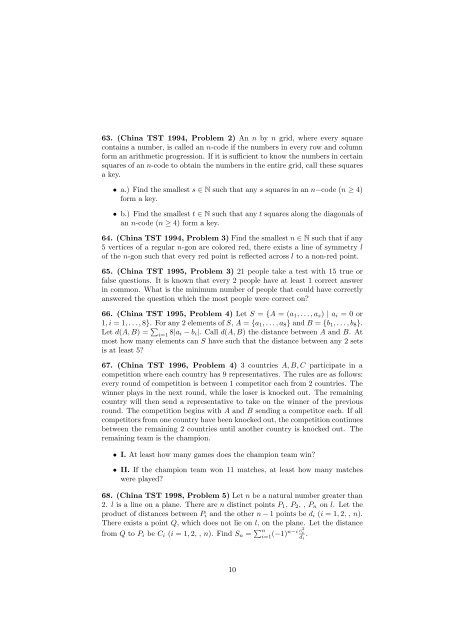Combinatorics Problems
Combinatorics Problems
Combinatorics Problems
Create successful ePaper yourself
Turn your PDF publications into a flip-book with our unique Google optimized e-Paper software.
63. (China TST 1994, Problem 2) An n by n grid, where every square<br />
contains a number, is called an n-code if the numbers in every row and column<br />
form an arithmetic progression. If it is sufficient to know the numbers in certain<br />
squares of an n-code to obtain the numbers in the entire grid, call these squares<br />
a key.<br />
• a.) Find the smallest s ∈ N such that any s squares in an n−code (n ≥ 4)<br />
form a key.<br />
• b.) Find the smallest t ∈ N such that any t squares along the diagonals of<br />
an n-code (n ≥ 4) form a key.<br />
64. (China TST 1994, Problem 3) Find the smallest n ∈ N such that if any<br />
5 vertices of a regular n-gon are colored red, there exists a line of symmetry l<br />
of the n-gon such that every red point is reflected across l to a non-red point.<br />
65. (China TST 1995, Problem 3) 21 people take a test with 15 true or<br />
false questions. It is known that every 2 people have at least 1 correct answer<br />
in common. What is the minimum number of people that could have correctly<br />
answered the question which the most people were correct on?<br />
66. (China TST 1995, Problem 4) Let S = {A = (a 1 , . . .,a s ) | a i = 0 or<br />
1, i = 1, . . . , 8}. For any 2 elements of S, A = {a 1 , . . . , a 8 } and B = {b 1 , . . . , b 8 }.<br />
Let d(A, B) = ∑ i=1 8|a i − b i |. Call d(A, B) the distance between A and B. At<br />
most how many elements can S have such that the distance between any 2 sets<br />
is at least 5?<br />
67. (China TST 1996, Problem 4) 3 countries A, B, C participate in a<br />
competition where each country has 9 representatives. The rules are as follows:<br />
every round of competition is between 1 competitor each from 2 countries. The<br />
winner plays in the next round, while the loser is knocked out. The remaining<br />
country will then send a representative to take on the winner of the previous<br />
round. The competition begins with A and B sending a competitor each. If all<br />
competitors from one country have been knocked out, the competition continues<br />
between the remaining 2 countries until another country is knocked out. The<br />
remaining team is the champion.<br />
• I. At least how many games does the champion team win?<br />
• II. If the champion team won 11 matches, at least how many matches<br />
were played?<br />
68. (China TST 1998, Problem 5) Let n be a natural number greater than<br />
2. l is a line on a plane. There are n distinct points P 1 , P 2 , , P n on l. Let the<br />
product of distances between P i and the other n − 1 points be d i (i = 1, 2, , n).<br />
There exists a point Q, which does not lie on l, on the plane. Let the distance<br />
from Q to P i be C i (i = 1, 2, , n). Find S n = ∑ n<br />
i=1 (−1)n−i c 2 i<br />
d i<br />
.<br />
10
















